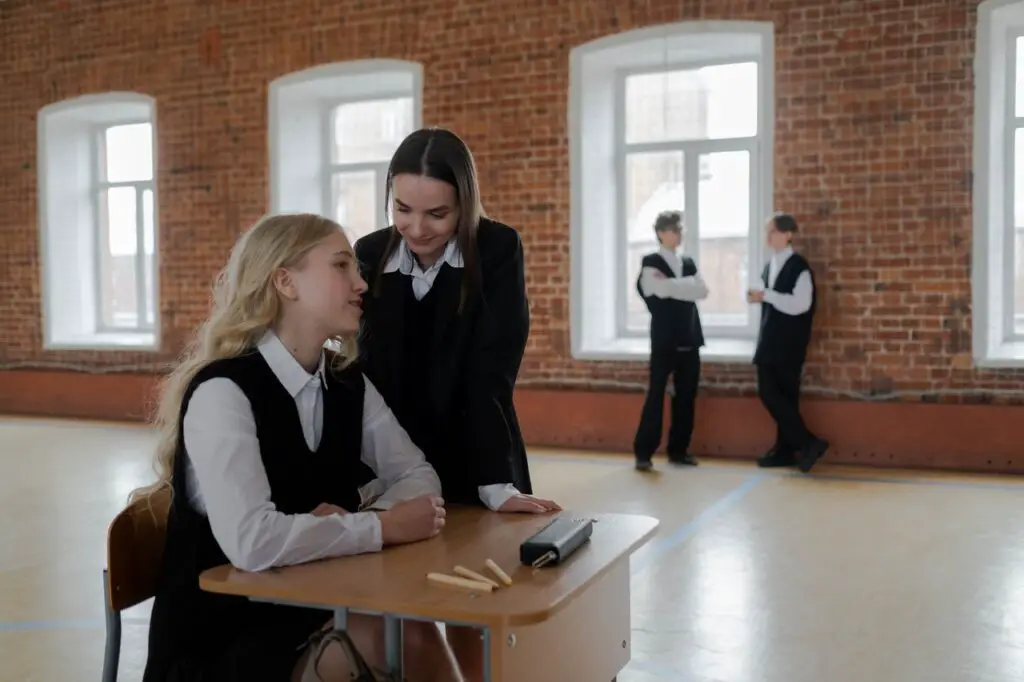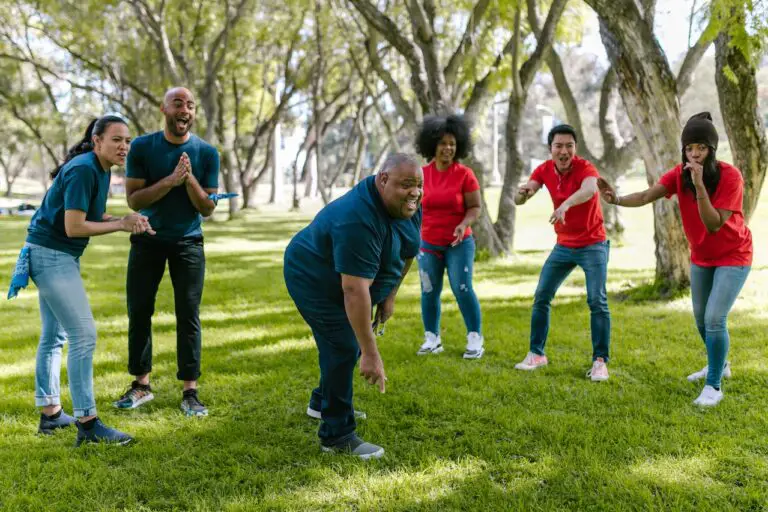I love role play when teaching. Not only does it add a flavour of excitement and energy to the class, but it’s a powerful method to get EFL/ESL students speaking English freely.
With teenagers and adults, especially, it helps break down barriers of self-confidence. Done right, it allows students to express themselves. But how exactly can you achieve this? Well, that’s what this article is all about!

When teaching EFL/ESL role play to teenagers and adults, creating a safe, supportive environment is vital. Allow students time and space to think. Provide helpful language before and during the activity without forcing them to repeat perfect sentences. Celebrate and encourage less confident students.
Unlike children, teenagers and adults often feel less comfortable role playing. I think that’s partly because it’s seen as “childish” and they don’t want to look silly in front of their classmates. Another reason can be a lack of self-confidence in their own English ability. But they’re missing out on a great learning experience.
For the full story of why I think role play is one of the best activities you can do in an EFL/ESL classroom, read my article Why All EFL/ESL Teachers Should Use Role Play Activities. And if you’re working with kids aged 8-12, check out How to Teach Children EFL/ESL With Role Play.
In this article, we’ll first take a brief look at what role play is, then I’ll tell you how to get the best out of it with students aged 13 and over.

Defining role play – what exactly is it?
Role play is unscripted, spontaneous acting out of given roles in certain situations. Scenarios can be as simple as two friends deciding which film to watch at the cinema, or be as grand as weekly 6-hour tabletop fantasy adventures.
For the purpose of EFL/ESL classes, it’s usually a brief (2-5 minutes) real-world experience. Each student imagines they’re in the scenario and, using dialogue, they resolve a problem or achieve a goal.
Example: Student A is a parent, Student B is their child. The parent is concerned about why their child has been failing at school and wants to know what’s going on. (Optional: Student C is the schoolteacher)
They’re generally open-ended and allow improvisation from all participants. As you can imagine, the language the students use has to be functional and communicative, and there’s less focus on perfect grammar and more on getting your message across.
Role play falls under the category of acted speaking activities, along with dramatization and simulation. To learn the differences between these three, read my explanation Dramatization vs Simulation vs Role Play: Guide for EFL/ESL.
How to get the best out of role play with teenagers and adults
Anyone who’s taught teenagers or shy adults will probably see how role play could be difficult to implement. Improvised acting can be embarrassing, especially in a second language.
But don’t give up so soon. The trick is to remove as much social pressure from the class as possible. When your students have nothing to fear, they’ll come out of their shells and express themselves with confidence. Here are 5 steps to achieving this.
1. Set the tone
First of all, you have to commit to role play yourself. If you aren’t comfortable doing it, you can’t expect your students to take risks.
Depending on the type of class you’re in, show them the attitude you want them to bring to the activity with an example. If it’s a serious business class, be a confident business person, shaking hands, talking with ease and pushing hard for deals.
On the other hand, if you’re with a group of teenagers, be bold and sometimes silly. Let them know they can do the same.
Setting expectations early on is key to getting your students on the same page. To find out how to best establish boundaries, read my article How to Set Rules & Expectations in Private EFL/ESL Classes.
2. Create a supportive and safe environment
This is the most important thing to get right. You need to establish this fact with every single student – this is a safe place where nobody’s going to mock them or make them feel bad for expressing themselves. Particularly with teenagers, if you get this wrong, it can lead to disaster.
In every class, there’ll be a few people who love performing and hogging all the attention. And there’ll be those who hate it. This latter group will not engage in the activity if there’s a risk of looking like a fool.
Make it clear to the class that the tone is light-hearted. By giving a good example in the previous step, you can show them they can push their limits without getting mocked.
Encourage shy students and give them praise when they take a risk. Never laugh at them. Only laugh with them if they’re deliberately trying to be funny.
3. Do the activity in groups of 2 or 3 and make performance optional
When the whole class is focused on their own scenario, they’re not paying attention to others. This massively reduces social pressure. Dividing the class into pairs or threes to do the role play all at the same time means you never expose your less confident students.
It’s also a good number because when you have larger groups, someone invariably struggles to get involved.
When everyone has had a go in their group, you can ask any confident students if they wish to repeat the activity in front of the whole class. This is a good opportunity for students to take risks and show off. However, it should be totally optional.

4. Provide target language before and during the activity
One common hurdle to role-playing activities is the struggle to find useful language in the heat of the moment.
To solve this, I like to let the students know what the scenario will be, then, as a class, elicit what words and phrases will be useful. This is a good time to introduce target phrases or grammar structures.
Write it somewhere clearly visible throughout the role play.
Elicitation is a great way of assessing and progressing language. To learn about elicitation for vocabulary, read my article How to Elicit Vocabulary in EFL/ESL: 7 Effective Activities.
While it’s underway, roam around the classroom. Your role is to provide language as and when it’s needed, as well as check everyone is on task.
Avoid forcing language on students. With such a spontaneous activity, parroted sentences and stock phrases come off rigid and false. Let them construct their own language using you as a resource.
5. Choose appropriate scenarios
This one is fairly obvious. Relevance is critical. Put your students in scenarios which they can relate to and engage with.
Get to know your class. Avoid cookie cutter scenarios (of which there are thousands online). They’re often boring and meaningless.
Instead, come up with scenarios to suit what your students like. If you’re teaching teenagers, don’t have them going to the supermarket to talk about the price of bread, but have them argue with a parent about getting a brand new phone.

If you’re teaching a business class, come up with role plays related to negotiation, interviews, meetings, etc.
Don’t be afraid to push the boat out. You can have plenty of wacky and unusual scenarios if your class is up for it. Put them in the middle of a hurricane, or falling out of a plane with only one parachute between them.
Saying that, know the limits of your group. If you take things too far, you might find students get disengaged when it gets too silly. If in doubt, start off calm and slowly increase the craziness.
For some great scenario ideas, check out my lists: 5 Awesome EFL/ESL Role-play Scenarios for Teens (+ tips) and 5 Engaging EFL/ESL Role Play Activities for Adults (+ tips).
Conclusion
The goal of role play activities is to provide an engaging situation in which students can practice speaking with real English. That’s all there is to it.
If every student is happily chatting away, solving problems, or having mock arguments, you’re doing it right.
For me, the most important thing is to start on the right foot. Make sure students know exactly what the activity entails and that they can do it without feeling stressed or embarrassed.
When you get this right, you’re giving them incredible opportunities to gain confidence and fluency. And have a bit of fun in the process!
For more information and guidance on role play in the EFL/ESL classroom, check out all my articles on the subject:
Why All EFL/ESL Teachers Should Use Role Play Activities
Dramatization vs Simulation vs Role Play: Guide for EFL/ESL
5 Problems to Avoid With Role Play in EFL/ESL + Solutions
How to Teach Children EFL/ESL With Role Play: Best tips
Teaching EFL/ESL to Teenagers & Adults With Role Play
5 Awesome EFL/ESL Role-play Scenarios for Teens (+ tips)
5 Exciting EFL/ESL Role Play Scenarios for Kids (+ tips)
5 Engaging EFL/ESL Role Play Activities for Adults (+ tips)









